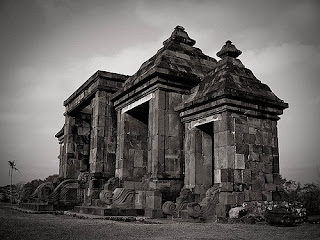Please note that those in charge of selling tickets to Prambanan practice race-based discriminatory pricing, with anyone who appears foreign being charged more than ten times the price of anyone who appears to be a local.
HOW TO REACH PRAMBANAN TEMPLE
The nearest major city is Yogyakarta, 17 kilometers away. Solo is also within easy striking distance.
By plane
Yogyakarta's airport is just ten kilometers from Prambanan. A taxi direct to the site should cost about Rp 20,000.
By bus
There are regular buses from Yogyakarta's Umbulharjo bus station (30 minutes, Rp 4000), as well as a wide variety of tour agency-operated minibuses shuttling directly to Yogya's backpacker haunts. Local buses to/from Solo are also easy to find (90 minutes, Rp 10,000).
TransJogja, Yogyakarta's newest bus service, also serves a direct route to Prambanan. The bus is air-conditioned and it costs Rp 3000 per person for a ride (as of 2008), regardless of the distance. Ask the attendant at TransJogja's bus stop for further details.
WHAT TO SEE IN PRAMBANAN TEMPLE
The main site of Prambanan contains four temples scattered about a large, landscaped park. The complex is open daily from 6 AM to 6 PM and entry costs a fixed US$10 (US$6 student), try to get there early to beat the heat. Guides can be hired at the ticket office, costs you Rp50.000
- Candi Lara Jonggrang, or simply Candi Prambanan, is the largest and most-visited of the temples ju st to the left of the entrance. While there were 232 temples originally built, most have long since crumbled and the main remaining attractions are the six temples of the central court, richly decorated with carved reliefs. Three of them, known as the Trisakti ("three sacred places"), are particularly important:
- Candi Siva, dedicated to Shiva the Destroyer, is the largest of the six, rising to a height of 45 meters. There are fine reliefs of the Ramayana in its forecourt and four chambers with statues. The largest chamber, to the east, contains a statue of Shiva himself, while the south has the sage Agastya, the west his son Ganesh (the elephant-headed) and the north his wife Durga. Durga is also known as Lara Jonggrang ("Slender Virgin"), a legendary beautiful princess turned to stone (see box).
- Candi Brahma, to the south, continues the story of the Ramayana and has a statue of Brahma the Creator inside.
- Candi Vishnu, to the north, tells the story of Vishnu's avatar Krishna and has a statue of Vishnu the Preserver inside.
- Opposite the three large temples are three smaller temples originally dedicated to the vehicles of the gods. Only the statue of Nandi, Shiva's bull, has survived.
- North of Lara Jonggrang is a poorly displayed museum laid out in a series of small houses connected by walkways. Explanations are minimal, but entry is free so you might as well take a look.
- Prambanan Audio Visual, inside the museum grounds, is the park's term for screenings of a bizarre movie entitled "Cosmic Harmony", which seems to spend as much time lambasting the "industrial world" in general (and Jakarta in particular) as explaining the Prambanan site. Still, it makes for a fairly entertaining half-hour break and Rp 2,000 is not too bad a price to pay for the air-con. The film is available in several languages.
- Candi Lumbung and Candi Bubrah, two Buddhist temples, are located several hundred meters further north. They lie in ruins and are fenced off.
- Candi Sewu, a large Buddhist temple complex meaning "one thousand temples", is one kilometer north of the entrance gate and contains a large central temple surrounded by a cluster of smaller ones. The sheer size of the recently renovated and intricately decorated central temple is impressive, but the statue niches are all empty. Entrance from the east side only.
There are also several temples and historical sites outside the park.
Kraton Ratu Boko, 3 km south of Prambanan, is a ruined palace or temple of uncertain origin, located on a hilltop 200 meters above the Prambanan plain (which makes for good pictures if and only if you have a good zoom lens). Only some building foundations remain and it's difficult to make any sense of the site. Now incorporated into the Borobudur Park Authority, entry to Ratu Boko is a separately charged US$10, which seems very steep for what you get.
WHERE TO STAY AT PRAMBANAN TEMPLE
The neighboring village of Prambanan has a few simple losmen if you want to spend the night, but most visitors daytrip from Yogyakarta or Solo.
Source: www.wikitravel.org
Image Source: www.indonesia.cz, antobilang.tumblr.com












No comments:
Post a Comment